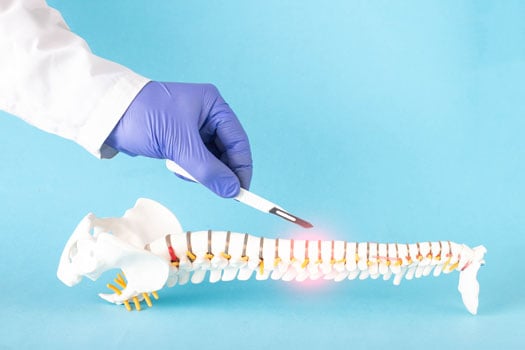
If the same disc irritates a nearby nerve again after the initial surgery and recovery period, it's referred to as reherniation. Painful herniation following a discectomy, the back surgery procedure often performed to relieve nerve pressure, is statistically on the low side. However, it can still happen under certain conditions. Here's what you need to know about what typically causes or contributes to reherniation after a microdiscectomy.
Movement of Disc Material
With a microdiscectomy, it's common for only a minimal amount of disc material to be removed to preserve spinal stability. While surgeons do make an effort to remove enough material to relieve nerve irritation, shifts in remaining disc material can occur later on and the material can protrude through the original hole in the disc. If this happens, symptoms may return in the immediate area or along the nerve's pathway.
Having a Higher Body Mass Index
A study involving more than 200 patients found those with a higher body mass index, or BMI, had an increased risk of revision surgery after a discectomy. The study showed the risk of reherniation increased as BMI increased.
Age-Related Factors (and the Hole in Your Disc)
Studies are mixed about age being a reherniation factor. However, the journal Spine makes note of research suggesting younger patients have a greater risk of reherniation after disc surgery. Part of the reason for this may be that younger adults are more likely to take risks with contact sports and similar activities that could overstress the same disc. They’re also more likely to have plenty of healthy material in their discs that can be liable to reherniate through the hole left after surgery.
Underlying Health Conditions that Aren’t Managed Well
Uncontrolled diabetes is one of the underlying health issues that may contribute to reherniation after a microdiscectomy. This can also apply to other health issues that aren’t managed well. If this applies to you, work with your physician to learn more about keeping any underlying health issues you may have under control.
Injuries Affecting the Same Area
Reherniation can also occur if the same area where surgery took place is injured. This might involve a hard impact or repetitive movements associated with work or daily life. Reherniation following a discectomy, in this instance, can be avoided or minimized by taking proper precautions with regular activities. For instance, you might use a lumbar support belt if you need to make the same general movements on a regular basis.
Not Being Mindful of Spine-Friendly Habits
Another possible cause of reherniation after a microdiscectomy is poor posture and similar habits that put added stress on the same disc or nearby ones. This is a risk you can mitigate after your discectomy by making an effort to incorporate the following spine-friendly habits into your life:
• Using proper lifting techniques
• Getting sufficient sleep
• Maintaining a healthy weight
• Eating foods that naturally ease inflammation
• Getting up to move as much as possible when sitting
Smoking/Tobacco Use
Smoking is one other unhealthy habit that could contribute to reherniation after a microdiscectomy. One study found patients still smoking at the time of their disc surgery were 50 percent more likely to experience reherniation. One reason is because chemicals in cigarette smoke affect circulation, which also affects how nutrients get to spinal discs. If the herniated disc that was operated on becomes weaker from reduced blood flow, reherniation may occur.
One of the main concerns with surgery is the significant risk of reherniation—where the same disc herniates again through a hole left after surgery. In fact, patients with these large holes in their discs are more than twice as likely to reinjure themselves by having what’s known as a reherniation. Fortunately, Barricaid is a bone-anchored barrier designed to close these holes, and 95 percent of Barricaid patients didn’t undergo a reoperation due to reherniation in a 2-year study timeframe. This treatment is done immediately following the discectomy—during the same operation—and doesn’t require any additional incisions or time in the hospital.
If you have any questions about the Barricaid treatment or how to get access to Barricaid, ask your doctor or contact us at 844-288-7474.
For full benefit/risk information, please visit: https://www.barricaid.com/instructions.


Comments